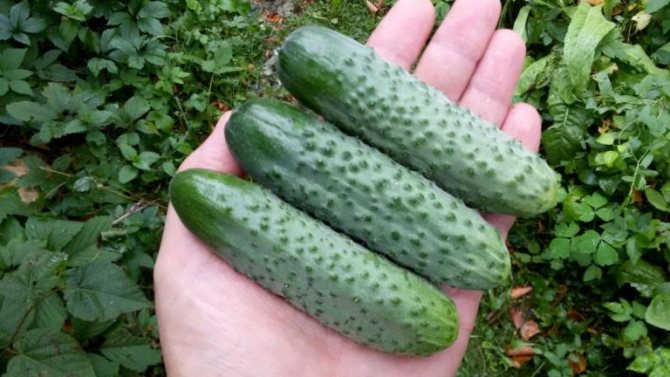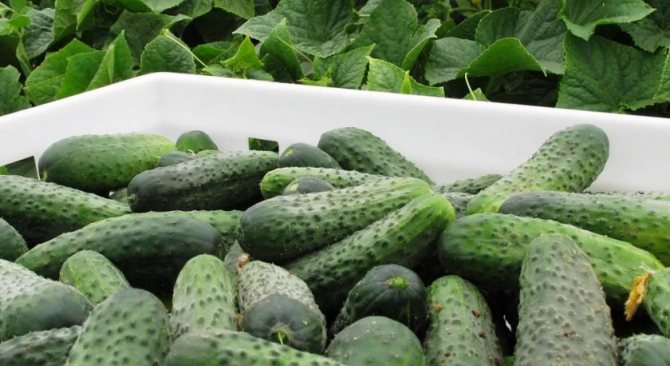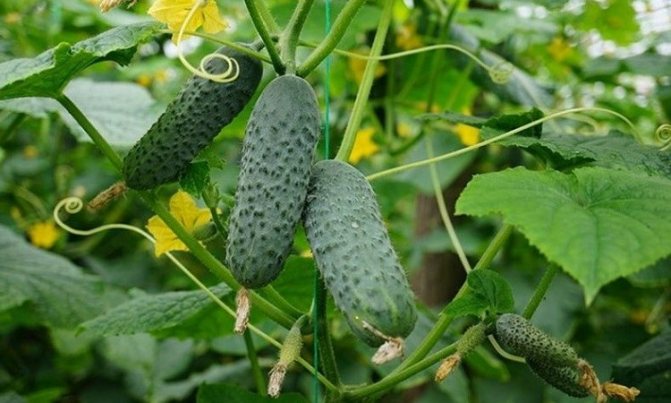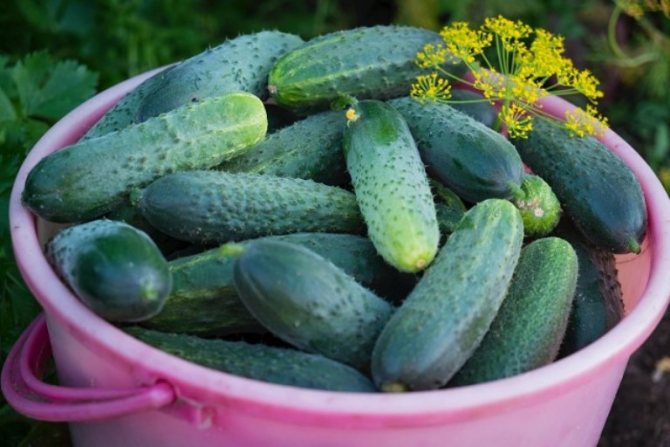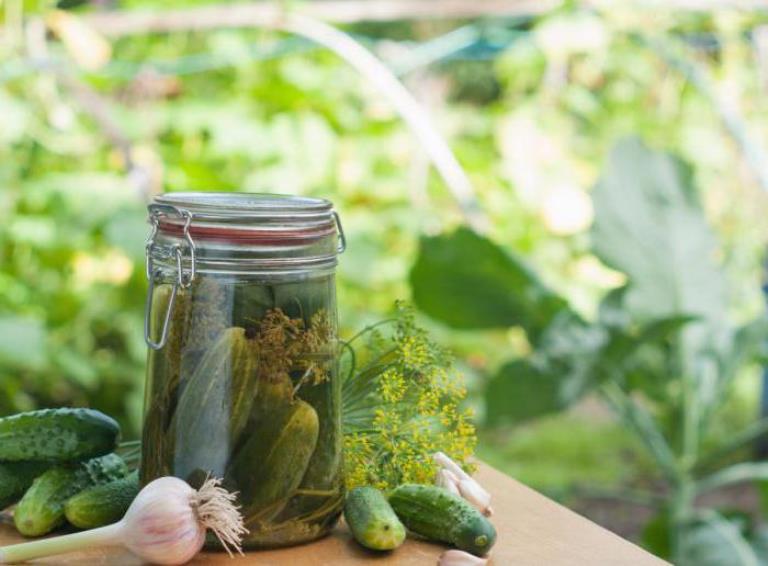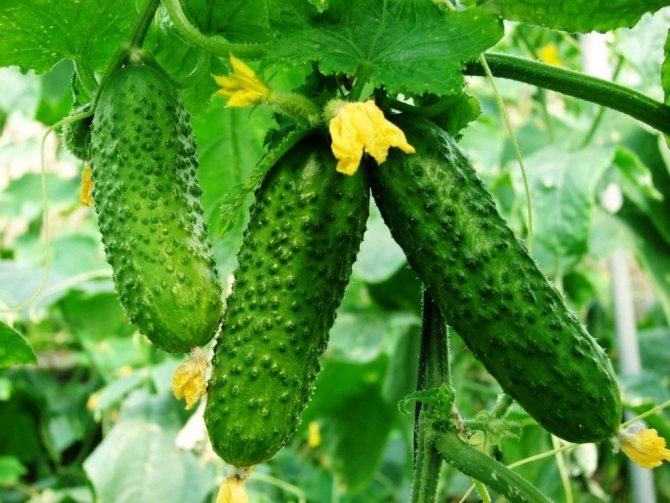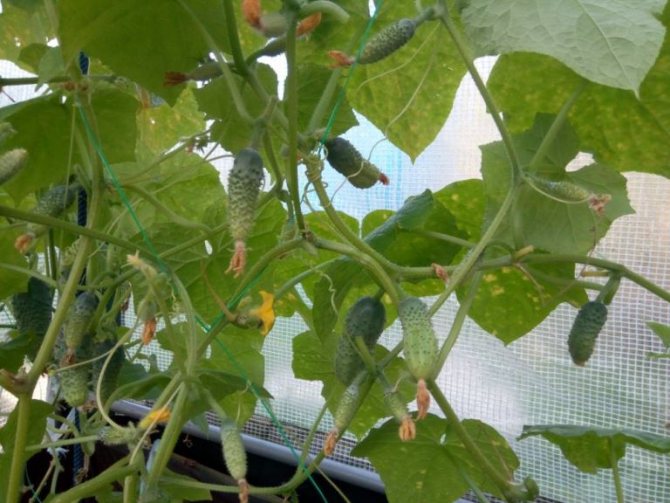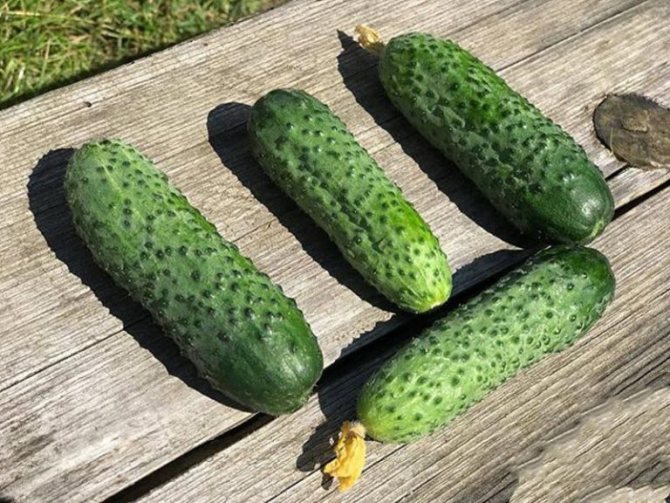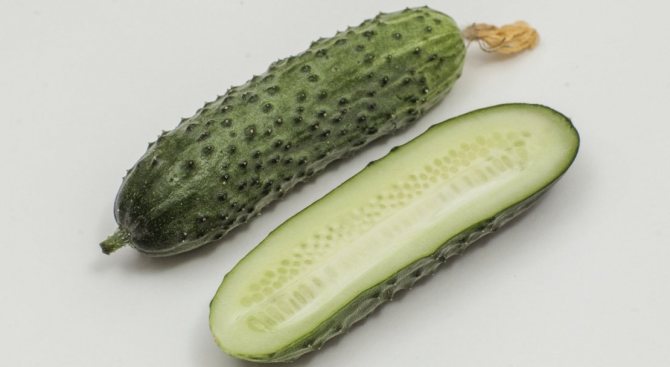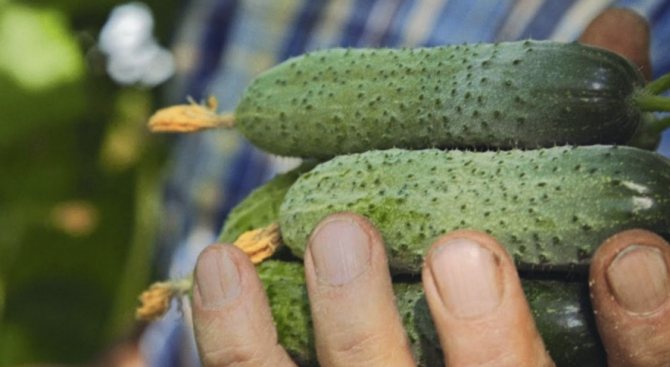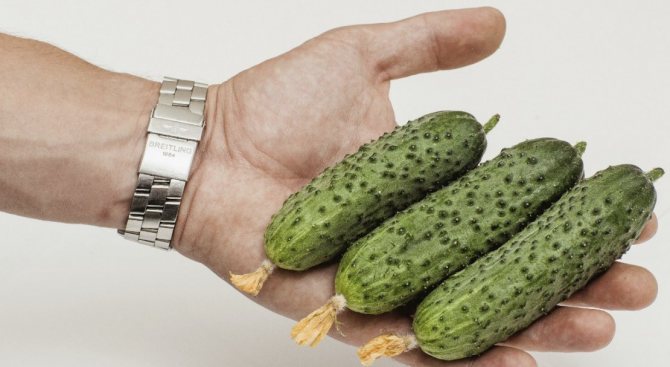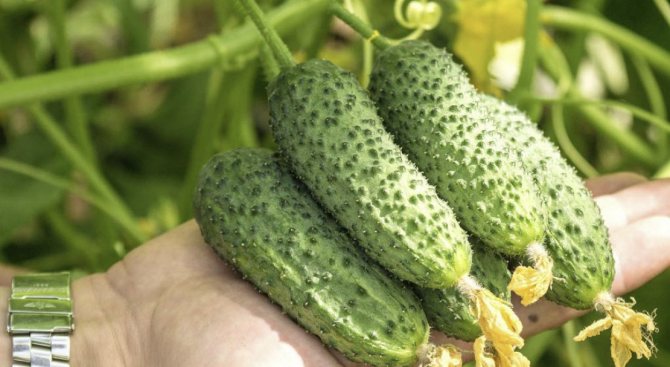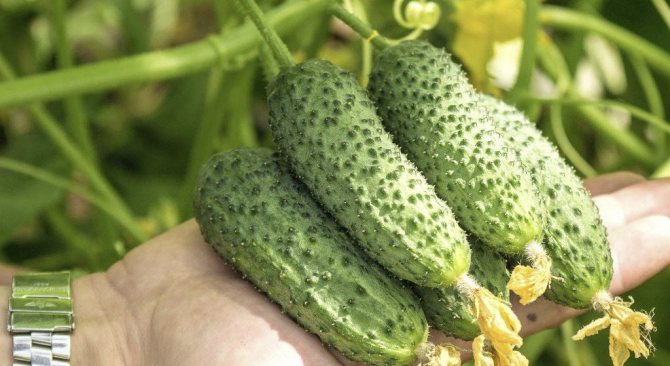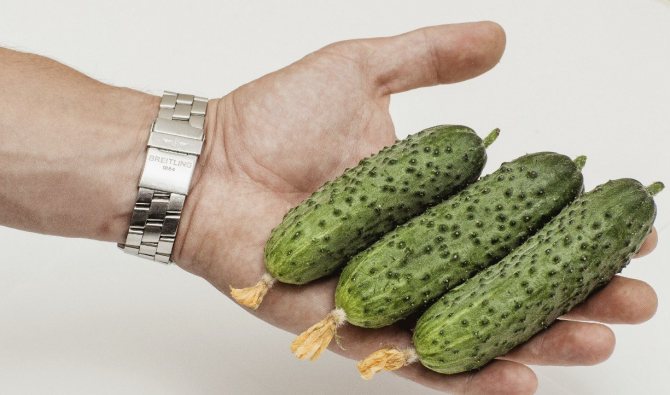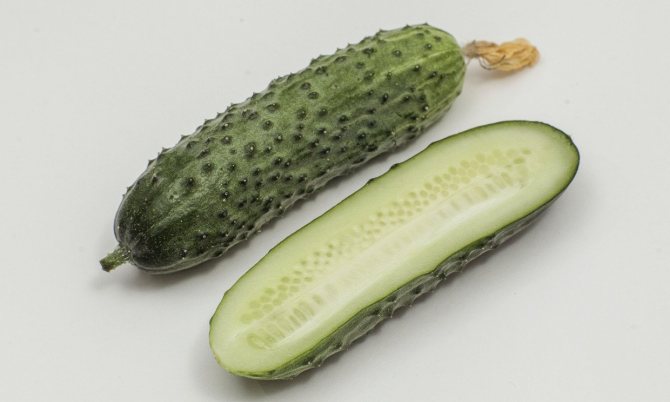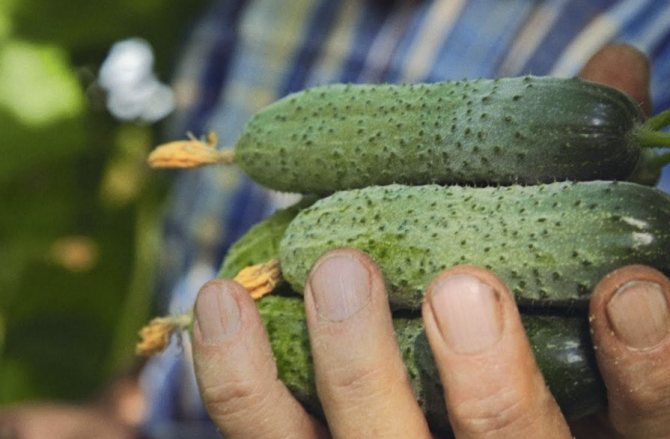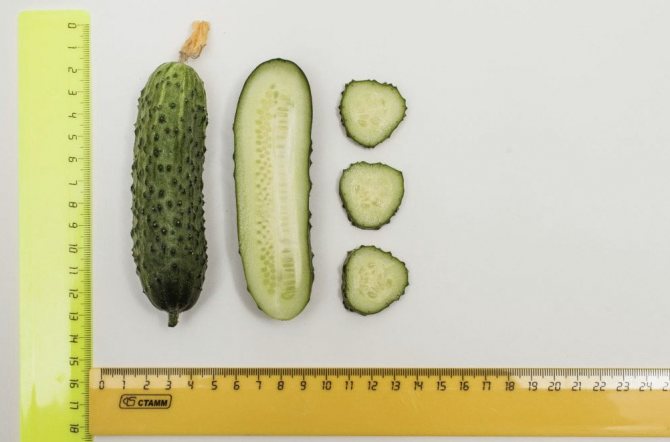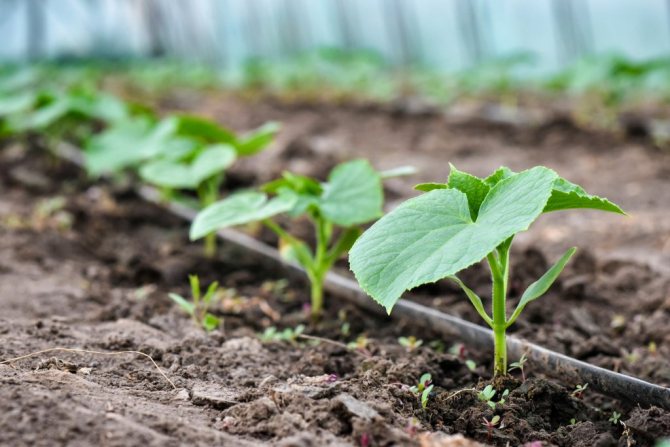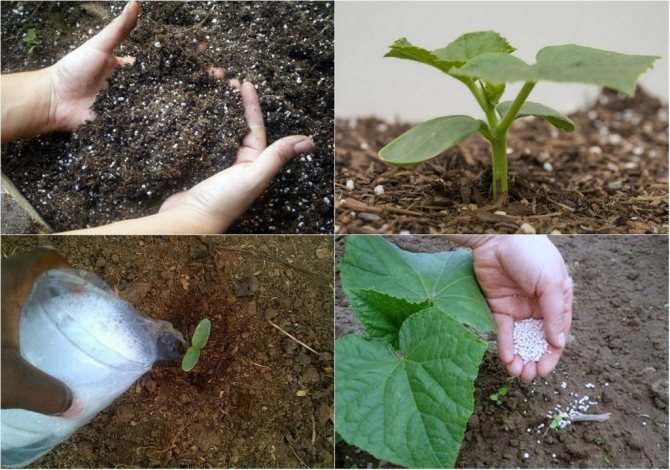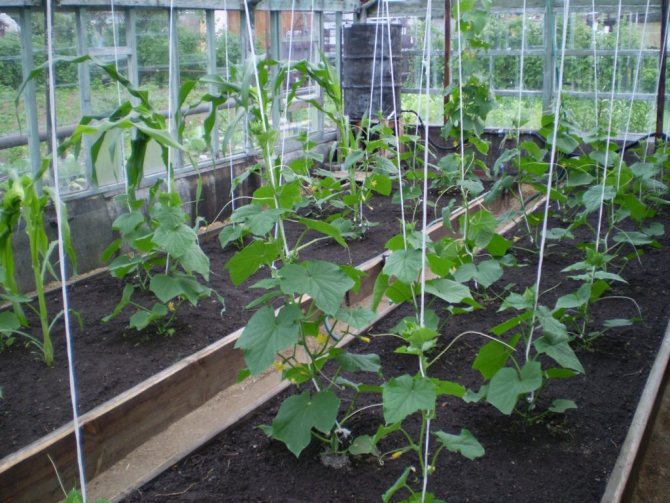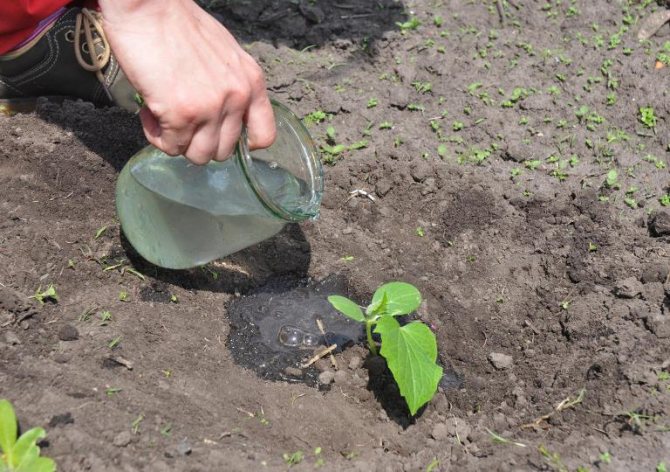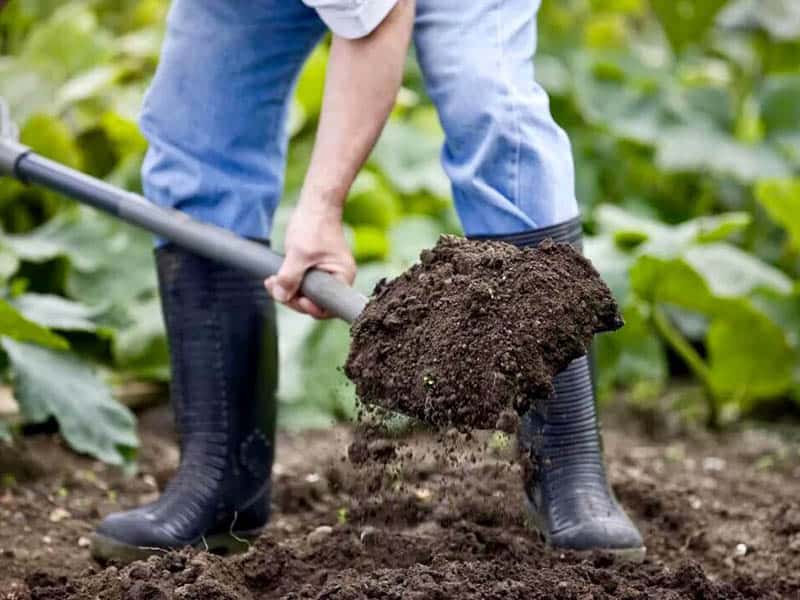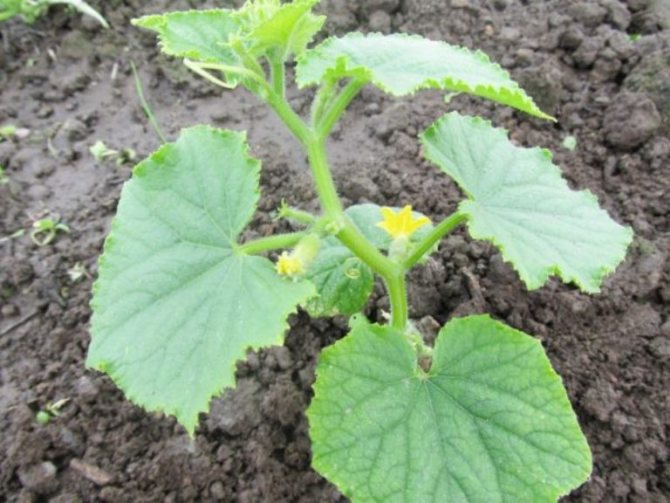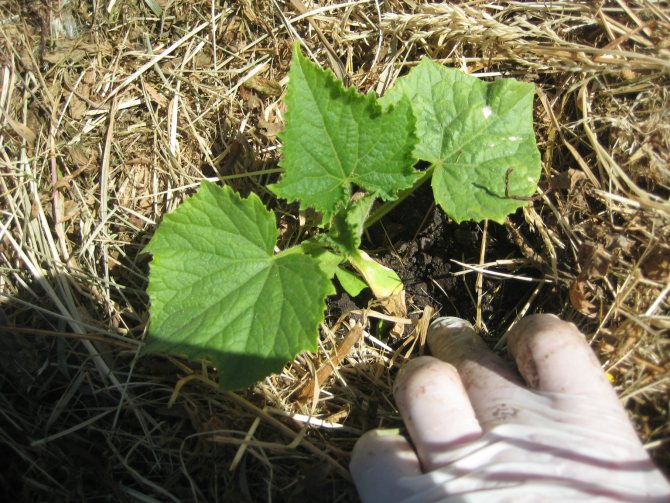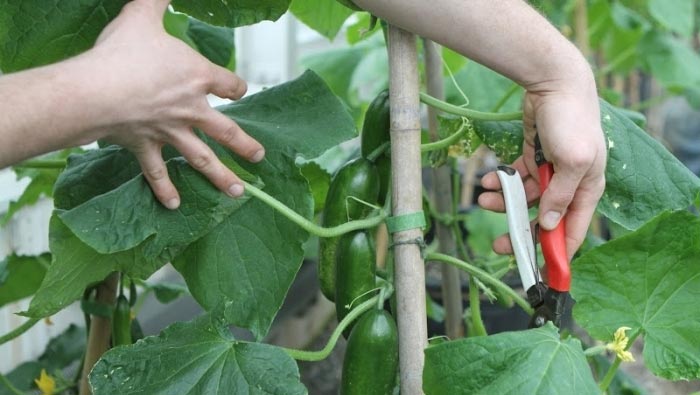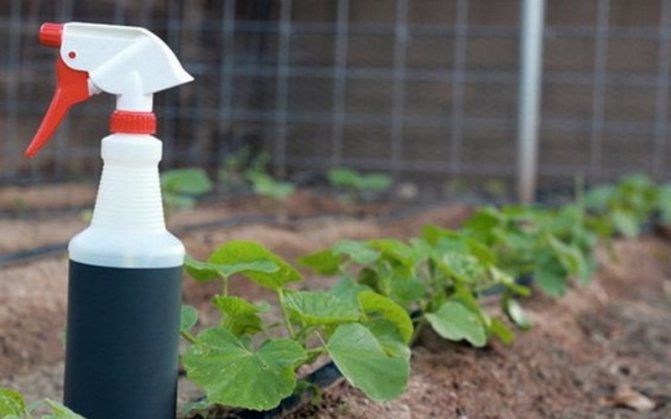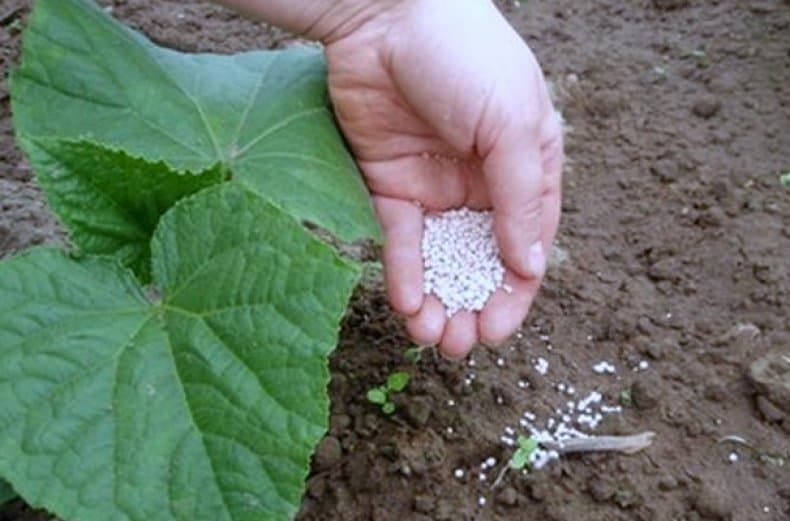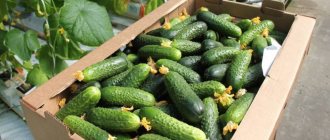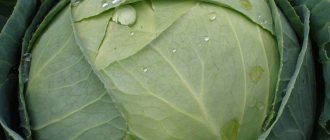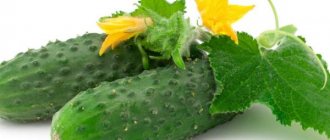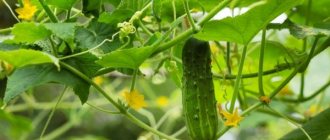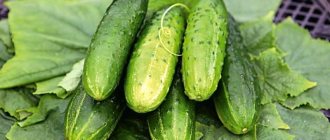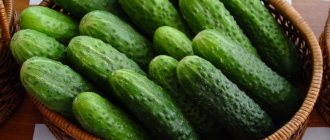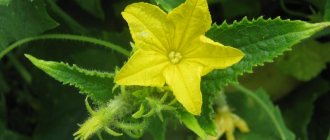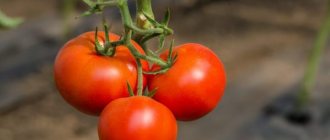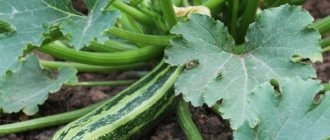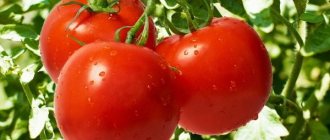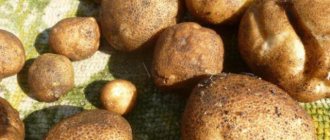Characteristics and description of the variety
Shosha cucumber is one of the most perfect products of Russian selection. Scientists have created a cold-resistant plant with excellent production and taste. This made it possible to cultivate crops in almost all regions, from the southern zone to the central and northern regions.
In addition, this hybrid is capable of excellent growth and development in:
- greenhouse conditions;
- room environment, on the windowsill;
- open ground.
Photo gallery
Did you know? Cucumber fruits appeared in culture about 6 thousand years ago and it is not surprising that this plant is mentioned even in the Bible. In the Holy Scriptures, the vegetable was characterized as one of the main food crops of the inhabitants of Ancient Egypt.
Productivity and fruiting
The growing season of the variety is short, only 39–45 days, after which the first fruits can be harvested. The fruit is small, up to 10 cm long and 3 cm wide, juicy, with a crispy skin and firm pulp. It is characterized by a rich dark green hue and a bumpy surface. The average weight of the fruit is in the range of 40–80 g, which allows harvesting from 1 m² of plantings up to 18 kg per season.
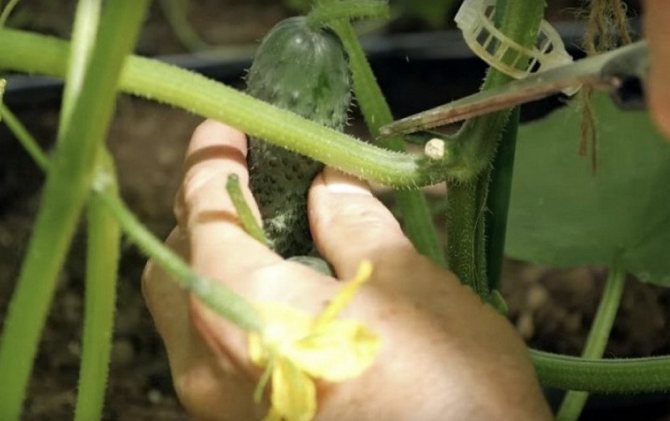
Application area
Shosha cucumber is ideal for fresh consumption, its rich and pleasant, sweetish flavor perfectly complements seasonal salads and other cold dishes. Fruits are also irreplaceable for the preparation of pickles, including when preserving whole. Such products are distinguished by high taste characteristics, as well as a long shelf life.
Pros and cons of growing
- The main advantages of the variety over related varieties of cucumber:
- excellent taste of both fresh fruit and culinary processed;
- excellent crop adaptability for pickling;
- high productivity;
- increased production and product characteristics;
- versatility, the plant is suitable for home and industrial cultivation;
- the fruits of the plant are rich in vitamins and all kinds of trace elements.
- The plant has few negative qualities:
- does not differ in increased resistance to some specific diseases;
- cannot be grown from seeds of its own collection, since it is obtained in the process of direct crossing of the original varieties;
- has no unique taste characteristics.
Agrotechnics
In order for the variety to be able to form an early harvest, it must be grown in seedlings. The planting time is calculated taking into account the rapid growth of the culture, the Furora seeds are sown about 25 days before the intended transplant. Seedlings that appear with insufficient lighting must be supplemented and kept at a temperature of at least + 27 ° C. After the appearance of side shoots, the temperature is lowered to + 18 ° C or + 23 ° C, watering is carried out only with warm water, you can spray it from a spray bottle.Seedlings ready for transplanting should have at least 6 true leaves. The recommended planting density is 3 - 4 pieces per 1 square meter. The soil must be nutritious, moisture and breathable. A few days after transplanting, the bushes are tied to a trellis. At a height of 80 cm from the soil surface, all side shoots of the cucumber can be removed. On the remaining shoots, the ovary that appears in the axil of the first leaf must be preserved, and then, after 2 or 3 leaves, the growth of the shoot must be limited. Care is simple - the plant must be provided with good watering and feeding. It is also necessary to carry out weeding and loosening.
Read also: Natali red currant: variety description, photos, reviews
Furor, or Furo, has shown very impressive results during the test growing. Disease resistance, excellent yield and a continuous process of fruit formation during the growing season make the variety interesting not only for growing on personal subsidiary plots, but also on an industrial scale. Despite the fact that the variety is new, no shortcomings have been identified in the process of its cultivation. But growers will have to purchase cucumber seeds annually.
Optimal timing for planting
Today, in horticulture, there are two ways of cultivating cucumbers, which cannot but affect the general method of growing them, as well as the timing of sowing. The so-called method of seedling cultivation and direct sowing into the soil is known. The first is used for cultivation of a culture in the temperate and northern zone, characterized by a short summer, as well as low temperature indicators. The second one when growing a variety under artificial conditions or in southern regions with a warm and mild climate.
For seedlings, cucumbers are sown in the second half of February or at the beginning of March. Thus, by the end of May, the plants will have reached a phase of 3-4 leaves, which is best suited for diving young cucumbers into open soil or further growing in greenhouse and indoor conditions. Sowing directly into natural soil is carried out when the average daily temperature of + 15 ° C is reached.
Did you know? The homeland of the cucumber is considered the forest regions of India, as well as the foothills of the Himalayas. In this area, you can still find wild forms of vegetables to this day.
Breeding history
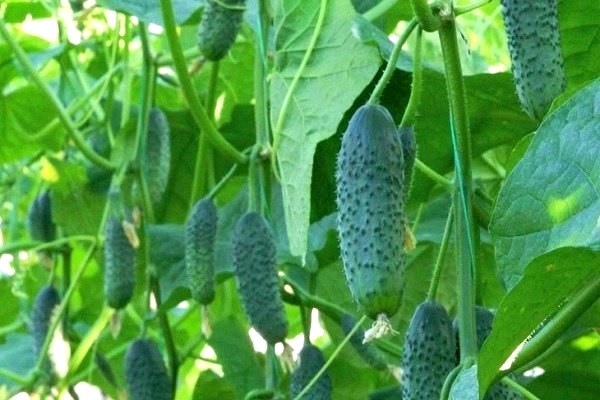

A new productive hybrid developed by Dutch agro specialists. She is the leader in the global seed market. The company has greenhouses in different countries; vegetable seeds are produced all year round.
Cucumber Cedric F1 has already conquered the world. It is grown in greenhouses around the world. In Russia, it was tested in 2020, the variety was entered into the state register:
- regions of admission - all;
- place of cultivation - indoor ground.
Important! The Cedric hybrid does not need pollinating insects. It can be grown in an apartment, greenhouse.
In the open field F1 Cedric is grown by farmers and summer residents of the southern regions and the Volga region. In greenhouses, it bears fruit in any climate.
Planting and growing cucumbers
This variety requires standard measures and skills, so even a beginner can grow it. In this case, you should definitely choose for yourself a method of growing a cucumber, on which the general agricultural technology of growing a crop depends. It should be remembered that a cucumber is a representative of tropical plants, therefore, the subtleties of its cultivation must be strictly observed.
Planting seedlings
Cultivation of Shoshi by the seedling method has a lot of advantages, the main ones being almost 100% yield of sprouts from seeds, as well as shorter ripening periods for cucumber fruits. The process begins with the choice of soil, only fertile, well-fertilized soils, rich in both organic and mineral compounds, are suitable for the procedure. A mixture of equal parts of humus and sod land is best suited for this.
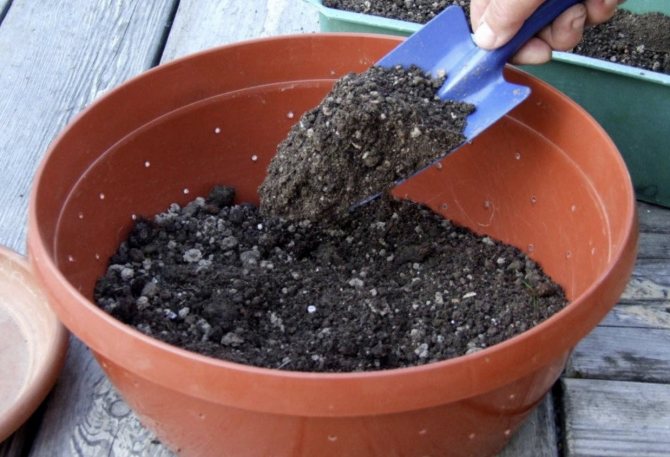

For 10 liters of such a substrate, add:
- 1 cup crushed wood ash
- 20 g superphosphate;
- 10 g of potassium sulfate.
The seeds of this cucumber do not need additional preparation, they undergo painstaking selection and processing with all kinds of growth stimulants. But, in order to increase the germination of the seed, the seeds need to be germinated. To do this, they are wrapped in a damp cloth and transferred to an environment with a temperature of + 25 ° C. In 3-4 days, the seeds will swell and give a small sprout, after which they can be safely placed in the soil.
Cucumbers are planted in common large containers and individual pots. They can be made of any materials, but the main requirement for them is the height. It should be about 10 cm long, which will allow the seeds to root safely and develop a powerful root. The bottom of the tank should have a drainage hole and a layer of gravel, fine gravel or broken brick, releasing excess soil from the substrate.
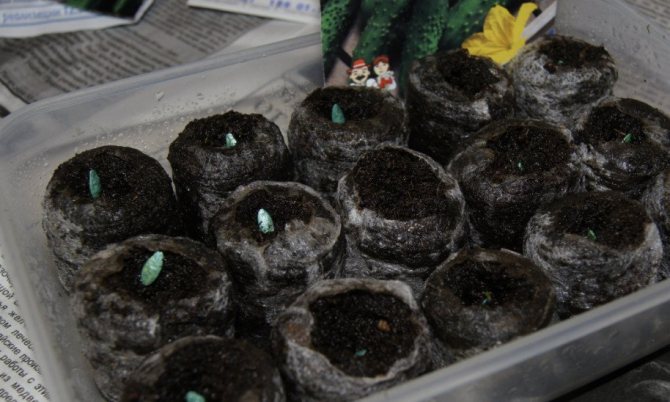

Seeds are sown to a depth of 3-4 cm, while the distance between each hole should be about 5 cm. After sowing, the containers are watered abundantly and, if possible, covered with transparent polyethylene or glass. This will help create greenhouse conditions above the soil surface, which favorably affect the development of sprouts. Without this, the speed of their emergence decreases significantly.
Important! There should be about 2-3 seeds in each hole, this will help protect against low germination of the seed. However, in the future, no more than 1 seedling should be left in one hole.
After that, we follow the sprouts to create the appropriate care and maintenance regime. For this:
- the sown flowerpots are transferred to a well-lit (with a daylight hours of at least 10 hours a day) and warm place (with a temperature of + 22 ... + 26 ° С);
- seedlings are provided with moderate, but daily watering;
- after the appearance of 2 leaves, it is imperative to remove the protective shelter (gradually, over several days);
- sprouts are provided with regular loosening, 1-2 times a week;
- extra ovaries are cut off;
- if necessary, the plants are tied to a support.
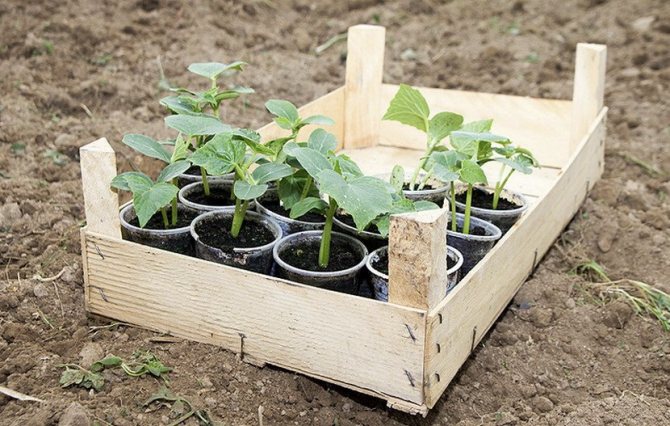

To further transplant seedlings into open soil, they begin when all the plants enter the 4-leaf phase. For this, a stable thaw and temperature regime must form, not less than + 14 ... + 16 ° С. Presumably, depending on the region of cultivation, this time comes from the end of April to the second half of May.
Seedless method
Any soil is suitable for sowing cucumbers by the non-seedling method, but the crop bears fruit best of all on well-fertilized substrates with a high humus content (chernozems, fertilized sandy loam and loamy soils). To achieve this, the site is well fertilized with compost or manure (6 kg / 1 m²), as well as potash and mineral mixtures (20 g of superphosphate and 10 g of potassium sulfate are added per 1 m²). Only open, well-lit areas are suitable for growing a vegetable. If you plan to grow a cucumber on a stem, they should also not shade each other.
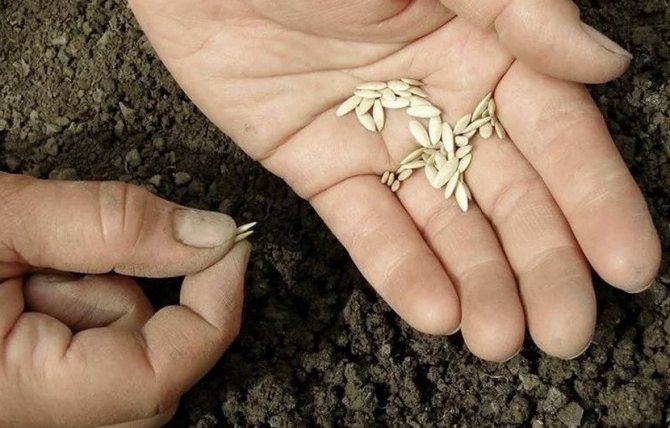

Fertilize the soil allotted for planting begins in the fall. This is necessary so that organic compounds have time to transform and saturate the substrate. In addition, since autumn, the soil must be loosened to a depth of about 20 cm. This contributes to its instant freezing in winter, which destroys dangerous pests in the soil, as well as pathogens of many infections. If possible, in the spring, the site is fertilized with mineral nitrogen, it will help accelerate the growth and development of young cucumbers. For this, dry and liquid forms of urea (50 g / 1 m²) are used.
Seeds are sown into open soil using a row method. To do this, in the allotted area, rows are cut with a depth of about 4-5 cm, with a row spacing of 40-50 cm. In each row, the seeds are placed in groups of 2-3 pieces, at a distance of 10 cm from each other. After the sprouts sprout, the beds are carefully thinned out. Thus, there should be a space of at least 10 cm between each adult sprout.
Important! Cucumbers should be grown after carrots, cabbage, onions, tomatoes, bell peppers. In turn, you should not cultivate the plant after melon and pumpkin.
Caring for cucumbers after planting
Shosha cucumber requires standard post-plant care. They consist in the correct and timely implementation of watering, fertilizing the bushes, as well as garters, without which it will not be easy to achieve high yields. In addition, the vegetable must be treated against diseases and pests, which often lead to the complete death of cucumber plantations.
Fertilizers and the correct irrigation regime
Cucumbers are watered regularly, this culture is quite demanding on moisture, so the procedure is carried out daily. The beds are not watered abundantly, therefore, it is necessary to achieve such a water regime in which the upper 10 cm of the soil will be constantly well moistened.
Abundant watering at long intervals is undesirable for cucumbers, such a regime is not able to provide the plant with the necessary moisture, which dramatically affects the size and quality of the fruits. Water is applied to the beds both at the root and by horse, but only with alternating methods, the highest crop yield is observed.
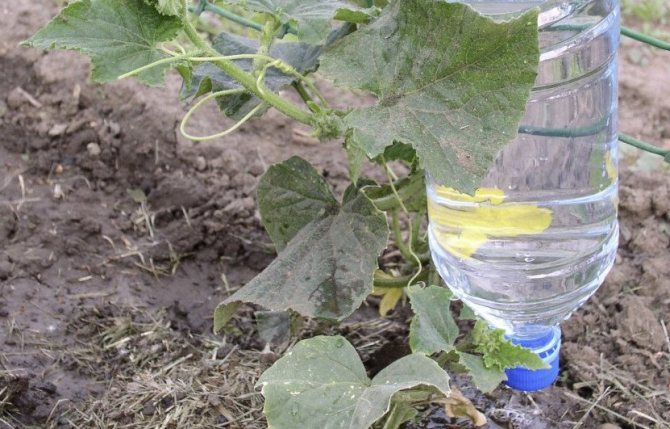

Fertilize cucumbers several times per season. For this, both mineral and organic dressings are used. Organic matter is applied 2 weeks after planting the seedlings, not earlier than in the phase of 4-5 leaves. For this, solutions of manure (1: 5) or chicken droppings (1: 7) are used, such replenishment per 1 m² should not be more than 5 liters. Before or during flowering, cucumbers are fed with mineral additives, the most suitable for this would be a mixture of 20 g of superphosphate and 10 g of potassium sulfate (for 1 m²). Dissolve them in 10 liters of water and add to the root.
It is important to know how to cut cucumbers correctly and for what.
Bush garter and shaping
Preparation for the garter begins even during sowing of seeds or when transplanting seedlings into open soil. To do this, a support about 2 meters high is installed near each plant from wooden pegs or metal rods. As it grows, the cucumber is attached to the support, tied with twine.
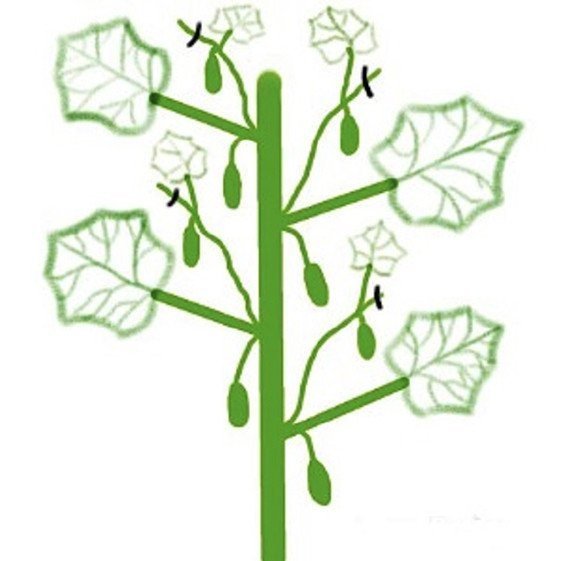

You can replace such a support with a general structure consisting of 2 racks and a horizontal bar. It is installed along the entire row, after which a garter of twine, fixed to a splitter, installed in the root zone of each sprout, is lowered from the horizontal bar to each plant. As it grows, the cucumber is braided around the twine, which becomes the main support.
Cucumbers are formed already in the phase of 8-9 leaves. During the procedure, you need to completely remove the lateral branches at the bottom of the plants. Those that are in the middle part are shortened by 1 forming fruit and leaf. The apical shoots are cut into 2-3 leaves. Thus, it is possible to achieve an even arrangement of fruits on the bush, as well as avoid wasting the plant's energy on the maintenance of irrational parts.
Soil care
Like any other agricultural crop, cucumber cannot stand competition with weeds, which sharply reduces its yield. That is why the weeding of the beds is carried out regularly, in order to avoid the appearance of any third-party vegetation. The procedure is carried out 1-2 times a week, to a depth of 5 cm. Loosening is often combined with weeding and is additionally performed after heavy or prolonged rains. It helps to saturate the soil with oxygen, which improves not only the crop yield, but also the cucumber's resistance to a variety of adverse factors.
Find out what to do to prolong the fruitfulness of your cucumber.
Cucumbers are mulched as early as possible, immediately after planting seedlings, or in the phase of 2-3 leaves (when cultivated in a seedless way).Mulching is carried out using sawdust, bark and other natural materials; they can be replaced with special agrofibre made of polymer materials.
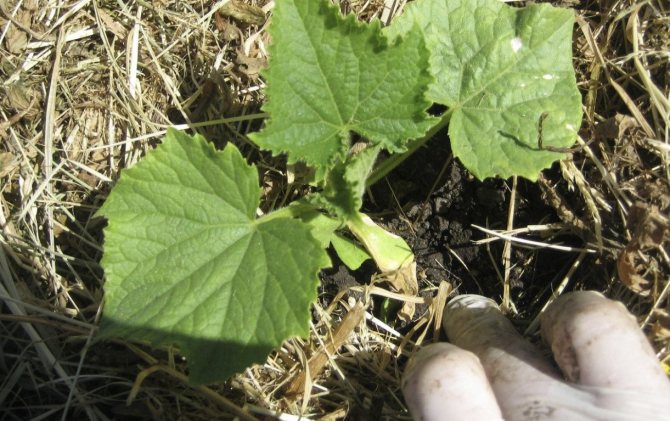

Timely mulching makes it possible to:
- avoid soil moisture loss;
- resist the weathering of minerals from the substrate;
- eliminate the possibility of freezing of the root system;
- exclude hilling bushes;
- create a special microclimate in the soil;
- reduce the need for frequent loosening of plants.
Possible growing difficulties
Since the Shosha variety is considered an unpretentious plant, difficulties with it arise only if the necessary rules and maintenance measures are not followed.
Find out why cucumber ovaries turn yellow and how to deal with it.
This leads to the emergence of favorable conditions for the development of various specific diseases and all kinds of pests in the growth zone of plantations. They cause yellowing, curling of the foliage, as well as inhibition of the growth of the cucumber and a decrease in its yield.
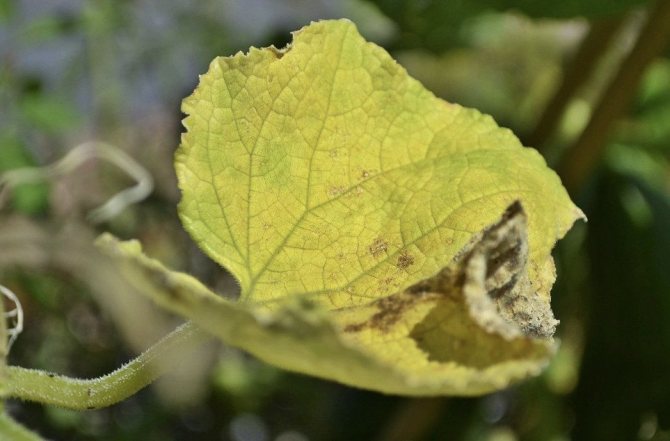

Diseases and pests of Shosh cucumber and methods for their elimination:
| Parasitic organism | Symptoms of defeat | Elimination methods |
| Cladosporia | Dark brown spots on foliage and fruits | The bushes are treated with a solution of copper sulfate (1:10) |
| Nematode | Foliage yellowing, ovary falling off | The affected parts are sprayed with copper sulfate (aqueous solution 1:10) |
| Aphid | Small pale dots on the lower part of the foliage, with abundant reproduction, they lead to wilting of the green mass | Plantations are treated with a 2% solution of potassium permanganate |
| Leaf roll | Small green caterpillars (about 2 cm long) feeding on plant leaves | Bushes and nearby soil are treated with garlic infusion or potassium permanganate solution (2%) |
Pest control
Cucumber Furor suffers from a number of pests:
Appears in July and August. A large number of pests on the leaves leads to the death of the plant. Ladybugs, which are attracted with the help of dill or mustard, help to fight them. Also, cucumbers are treated against aphids with onion or garlic infusion or tobacco infusion with the addition of laundry soap.
Read also: Ammonium nitrate and potassium for cucumbers: application
Spider mite
This parasite infects plants in greenhouses. To combat it, a store-bought remedy is most often used. Soap solution also helps.
Harvesting
The first harvests of Shoshi are harvested 40 days after the start of the active growing season. At this time, the first fruits reach a length of 10 cm, which is an ideal size for fresh consumption and further culinary processing. The picking of gherkins is carried out 7-10 days earlier. Harvesting is carried out gradually, selecting only the fruits of the required size. The cucumbers are plucked together with the stalk, after which it is shortened to 0.5 cm for long-term storage. As such, at 0 ... + 5 ° C, the cucumber is able to fully store its freshness for 10-14 days.
Important! During the period of mass fruiting, the fruits must be harvested every 2 days, otherwise this will lead to the appearance of overripe cucumbers, which reduces the crop yield significantly.
The hybrid form of the Shosha cucumber has won its popularity among vegetable growers due to the excellent quality of the fruits, unpretentiousness in keeping conditions, as well as high yield. In addition, this plant is not afraid of powdery mildew, cucumber mosaic and target-like spotting, due to which the post-planting care of the crop is facilitated at times. Grow on your Shoshu plot and you will surely see all the benefits of this variety.

